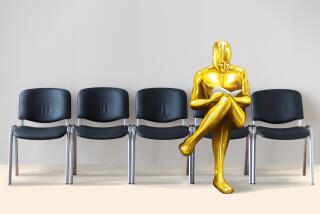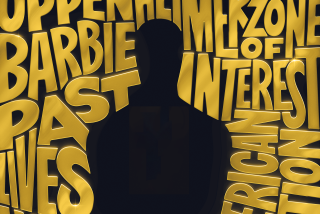In Hollywood, female film directors are still the exception
By many counts, 2009 was a great year for women in Hollywood. Female directors knocked out such hits as “The Proposal,” “Alvin and the Chipmunks: The Squeakquel,” “It’s Complicated” and “Julie & Julia,” as well as the Oscar contenders “The Hurt Locker” and “An Education.”
Sandra Bullock and Meryl Streep outperformed most of their male counterparts dollar for dollar at the box office, nabbing Oscar nominations to boot. The elusive female movie-going audience has started to gel into a potent force, driving such hits as the “Twilight” franchise, “The Blind Side” and this weekend’s “Alice in Wonderland.”
Now comes the capper, as Kathryn Bigelow stands poised to become the first woman to win an Oscar for directing, after spending seven years in proverbial director’s jail because her last film, “K-19: The Widowmaker,” flopped at the box office.
After winning numerous critic awards and the prestigious Directors Guild of America directing award, Bigelow is favored to take tonight’s prize for directing “The Hurt Locker,” her film about bomb-disposal technicians in Iraq that is also nominated for best picture.
Bigelow’s likely ascension to the podium at the Academy Awards has provided a jolt of adrenaline.
The director lent her own idiosyncratic eye to the most male of genres, the war film.
But she is considered by many in the business to be more of an outlier, an exception to the rule as a woman who’s made her name largely directing men in action films such as “Point Break” and “Strange Days.”
Most female directors have risen to power by directing (and often writing) films that appeal to women, whether or not that’s their natural inclination.
That’s one reason why one of the film’s producers, Nicolas Chartier, found it easier to raise the funds for “The Hurt Locker” by selling the foreign rights than from Hollywood studios.
“When you meet foreign audiences, you could see there’s a deep appreciation for her work, maybe even more so than in the U.S.,” said another of the movie’s producers, Greg Shapiro.
In Hollywood, few women like to be singled out as female directors per se. Bigelow declined to be interviewed for this article for that reason, her publicist said.
Although successful female directors appear to have gained higher profiles of late, the actual percentage of top films directed by women has remained static for 25 years at 7% to 9%, according to an annual study of women writers, directors, and producers of the 250 top-grossing films of the year by the Center for the Study of Women in Film and Television at San Diego State University.
“We’re running in place. There’s been no progress since 1987,” said Martha Lauzen, the center’s executive director.
For instance, neither Warner Bros., the world’s largest studio, nor Paramount Pictures hired a single female director last year, while Walt Disney Studios and Universal Studios hired just one apiece. No woman has ever been hired to direct an event picture with a budget of more than $100 million, the kind of film most valued by the Hollywood machine.
Whether the director of a film is a man or a woman has a correlation to how many women appear in the film. The population might be more than 50% female, but actresses nabbed only 29.9% of the 4,379 speaking parts in the 100 top-grossing films of 2007, according to a recently released study by Stacy L. Smith, a professor at the Annenberg School for Communications & Journalism at USC.
Only 2.7% of the directors on those films were women, but when they did step behind the camera, the percentage of female characters jumped dramatically, to as high as 44.6%, compared with 29.3% when the director was a man. Moreover, Smith said, the proportion of women on screen literally “hasn’t changed since the 1940s. It’s disheartening at best.”
Smith also discovered that women tended to be portrayed as “eye-candy.” Women were more likely to be shown in scanty clothing (27% vs. 4.6% for men) or displaying mild nudity, such as cleavage or thighs (21.8% vs 6.6% for guys).
Smith noted that Hollywood’s depiction of gender does affect attitudes in the culture, particularly among the young, re-enforcing the idea that “stories about women are not as important as stories about men. Some of the [research] about youth has shown that showing a limited range of occupations on screen is correlated with having restricted range of aspirations.”
But gender is a touchy subject for many women in Hollywood. Anne Fletcher, who directed the box office smash “The Proposal” as well as the hit “27 Dresses,” says, “I never think of gender, ever. For me, I’ve never in my entire career experienced sexism.”
Jane Campion, who won an Oscar for writing “The Piano,” acknowledges the relative paucity of female directors.
“It must be some kind of glass ceiling. I look at women studying law or medicine. They sit for the exams, and they get the result,” and they get good jobs. But she says she doesn’t give it much thought.
“I just see [the films] as my work,” she said. “I think every filmmaker or artist comes from that point of view. My guy friends don’t say, ‘This is my masculine work.’ Of course, [films] are going to be an expression of everything about you, but it’s limiting or ghettoizing to always say, because [you’re a woman], that first you’re a woman filmmaker.”
Campion is one of only three women besides Bigelow who have been nominated for the directing Oscar. She was nominated in 1994 for “The Piano.” Italy’s Lina Wertmuller was the first, for directing the 1975 film “Seven Beauties.” Sofia Coppola landed the nod for “Lost in Translation” in 2004.
Catherine Hardwicke is the only female director to launch a successful franchise. Although “Twilight” grossed $385 million at the global box office, Hardwicke has found it hard to set up her next film, but acknowledges that, like many male directors, she also has run smack into Hollywood’s recent belt-tightening, with studios dramatically cutting the number of films released.
But she acknowledges that there’s a gender factor.
“One producer was candid enough to say ‘We want to go to a guy,’” she said. “Other times you just feel it by the questions they ask you, or by not getting the meeting. A lot of people think that women can’t do [special] effects. That was my first job when I came to Hollywood, working in an effects house!”
After several projects failed to get greenlighted, Hardwicke is now waiting to begin “The Girl With the Red Riding Hood,” a gothic retake on the classic tale, based on an idea from Leonardo DiCaprio (who’s also producing) and starring Amanda Seyfried.
One apparent growth arena for women is in working for other women. Streep, for instance, told The Times that she attributes her box office renaissance to the fact that she opted to do three films, “Mamma Mia,” “Julie & Julia,” and “It’s Complicated,” that were written and directed by women, as well as backed by studios with women as presidents of production or even higher in rank.
Certainly, the fact that Bigelow is in the running for the Oscar has caused excitement and joy among many of her fellow directors who happen to be women.
“I’m deeply, deeply moved,” says director Julie Anne Robinson, whose Disney film, “The Last Song,” opens this month.
“When I first started getting the [Directors Guild] magazine, I would turn the pages and there would not be one woman face in the entire magazine. It was a standing joke. Honestly, it went on for months and months. To see a woman up there at the Oscars, it’s a dream come true. It’s fantastically inspirational to see that.”
“I’ve kept track of the previous three women who’d been nominated for the [directing] Oscar,” says writer-director Shana Feste, whose Sundance film “The Greatest” debuts in theaters in April. “I get tears in my eyes thinking about it. I’m rooting for her, man.”
rachel.abramowitz
@latimes.com
More to Read
Only good movies
Get the Indie Focus newsletter, Mark Olsen's weekly guide to the world of cinema.
You may occasionally receive promotional content from the Los Angeles Times.










